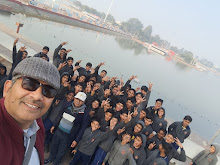International Journal of Humanities Social Science and Management (IJHSSM)
Volume 4, Issue 4, Jul.-Aug., 2024,
pp: 235-237
www.ijhssm.org
National Educational Policy (NEP 2020) and Role of Libraries
Dr. Rajendra S. Lawande College Librarian (Associate Professor)
Department of Central Library Radhabai Kale MahilaMahavidyalaya,
Ahmednagar-414001(M.S.
National Educational Policy NEP 2020 and Role of Libraries.pdf
Key Principles of Libraries as per NEP 2020:
Government of India is willing to promote the reading habit among the people of the country for maximum usage of library resources.
Now a day the libraries support 24×7 hours access to its users.
Today’s libraries store information and knowledge in digital form for all users.
The role of libraries as per National Education Policy 2020 of India will increase many folds.
- Availability and Accessibility of Books to all Communities
- Accessible and Affordable to Rural & Remote Areas
- Including Reading habit within Communities
- Libraries Strengthened and Modernize
- Books Published in all Local and Indian Language
- Online Accessibility and Digital Libraries
- Adequate Staff and CPD
- Children’s Mobile libraries & social Book Clubs
- Collaboration between Educational
Key Features of NEP 2020:
The National Education Policy (NEP 2020) is a comprehensive and transformative policy that aims to overhaul the education system in India. Some of the key features of the NEP 2020 are:
- Respect of diversity and local context
- Equity and inclusion
- Community participation and encouragement
- Use of implementation of technology
- Emphasizing conceptual understanding
- Fostering unique capabilities
- Critical thinking and creativity
- Continuous review and evaluation
II. Conclusion:
The National Education Policy of India 2020 recognizes the critical role of libraries in education. It calls for the development of well equipped libraries at all levels of education, including schools, teacher education institutions, and higher education institutions. The policy recognizes that libraries can serve as centers for learning and research, providing access to a wide range of resources, including books, journals, and digital media. The NEP's recommendations on libraries provide a framework for enhancing the quality of education in India and preparing students for the challenges of the 21st century. The Government should accept the needs of the library staff and appropriate staff has to be fulfilled to provide the better services from libraries.
21stcentury skills:
Analytical and critical thinking
Experimental learning
Creativity
Reduced curriculum
Teacher Training and Professional Development
NEP 2020 proposes establishment of a robust framework for continuous professional development, ensuring that teachers are equipped with the necessary skills and knowledge to deliver effective and learner-centric education.
- Use of technology in education:
- Preparing of digital content
- Establish digital infrastructure
- Utilization of online platforms for learning and assessment
- Early Childhood Care and Education (ECCE)
- For the age group of 3-6 years
- Play-based and activity-based learning
- Strong foundation for children’s cognitive, social and emotional development
- NEP 2020 Emphasizes:
- 1. Creativity
- 2. Critical Thinking
- 3. Problem Solving
- 4. Basic Skills
- 5. Life Skills
- PARAKH__________________________ ↓↓↓↓↓
- Reading and Writing- Phonemic awareness and phonics skills
- Multilingualism-Mother tongue/ Home language
- Remedial Education- Basic literacy and numeracy
- 1. Access
- 2. Equity
- 3. Quality
- 4. Affordability, &
- 5. Accountability
- Age group for Right to Education (RTE) increased from14 to 18 years
- 10+2 school system will be replaced by a 5+3+3+4 system
- Five years of foundation stage: (i) Ages: 3 to 8 years (ii) Class: Anganwadi or pre-school, class 1 & 2 (iii) Focus: play & activity- basedlearning method, development of language skills
- Three years of preparatory stage: (i) Age 8 to 11 years (ii) Class: 3 to 5 (iii) Focus: develop language and numeracy skills; play and activity-based teaching methods; includes classroom interaction, reading, writing, speaking, physical education, art etc.
- Three years of middle stage: (i) Ages: 11 to 14 years (ii) Class: 6 to 8 (iii) Focus: critical learning objectives, experimental learning in science, maths, arts, social science, humanities etc.
- Four years of middle stage: (i) Age: 14 to 18 years (ii) Class: 9 to 12 (iii) Focus: multidisciplinary education, develop critical thinking, flexibility and choice of subjects
- Academic Bank of Credit (ABC) is established to digitally store academic credits from different HEI (Higher Education Institutions)
- Multi- disciplinary Education and research University (MERU) to be established to emulate teaching learning methods of ancient India
- Higher education:
- Flexible undergraduate program (Creative Practice)
- Credit-based systems Vocational education and internships be incorporated into the curriculum
- Ensure Universal Access at All Levels of schooling from pre-primary school to Grade 12,
- Compulsory education for all children aged 3-6,
- Curriculum development and new teaching models (5+3+3+4),
- Establishing national mandates for basic literacy and numeracy,
- Language of instruction in class 8 and beyond will be home language/mother tongue/local language/regional language.
- Annual Assessments- Board examinations are conducted twice a year, one for mains and one for development, if required.
- Establishing a new National Centre for Baric Assessment (Performance Assessment, Review and Knowledge Analysis for Overall development),
- Equitable and Inclusive Education Special Emphasis for Socially and Economically Disadvantaged Groups (SEDG),
- Separate gender enrolment fund & special education areas for disadvantaged areas &groups,
- A robust and transparent process for faculty recruitment and merit-based presentation,
- Create school campuses and clusters to share all resources,
- Establishment of State School Standards Authority (SSSA), Exposure to vocational and higher education systems in schools.
- A fully multidisciplinary education system with multiple entry/exit options,
- NTA offers to take the Common Entrance Exam for HEIs
- Establishment of an education bank
- Establishment of Multidisciplinary Education and Research University (MERUS),
- National Research Foundation (NRF) Research and Development,
- Creation of Higher Education Council of India (HECI)- an independent body with a standards body- Public Education Commission, Funding Higher Education Grants Commission (HEGC), Accreditation- National Accreditation Council


No comments:
Post a Comment